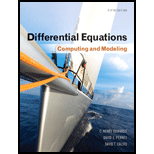
Differential Equations: Computing and Modeling (5th Edition), Edwards, Penney & Calvis
5th Edition
ISBN: 9780321816252
Author: C. Henry Edwards, David E. Penney, David Calvis
Publisher: PEARSON
expand_more
expand_more
Solutions are available for other sections.
Question
error_outline
This textbook solution is under construction.
Students have asked these similar questions
Q1: A: Let M and N be two subspace of finite dimension linear space X, show that if M = N
then dim M = dim N but the converse need not to be true.
B: Let A and B two balanced subsets of a linear space X, show that whether An B and
AUB are balanced sets or nor.
Q2: Answer only two
A:Let M be a subset of a linear space X, show that M is a hyperplane of X iff there exists
ƒ€ X'/{0} and a € F such that M = (x = x/f&x) = x}.
fe
B:Show that every two norms on finite dimension linear space are equivalent
C: Let f be a linear function from a normed space X in to a normed space Y, show that
continuous at x, E X iff for any sequence (x) in X converge to Xo then the sequence
(f(x)) converge to (f(x)) in Y.
Q3: A:Let M be a closed subspace of a normed space X, constract a linear space X/M as
normed space
B: Let A be a finite dimension subspace of a Banach space X, show that A is closed.
C: Show that every finite dimension normed space is Banach space.
• Plane II is spanned by the vectors:
P12
P2 = 1
• Subspace W is spanned by the vectors:
W₁ =
-- () ·
2
1
W2 =
0
Three streams - Stream A, Stream B, and Stream C - flow into a lake. The flow rates of these streams are
not yet known and thus to be found. The combined water inflow from the streams is 300 m³/h. The rate of
Stream A is three times the combined rates of Stream B and Stream C. The rate of Stream B is 50 m³/h less
than half of the difference between the rates of Stream A and Stream C.
Find the flow rates of the three streams by setting up an equation system Ax = b and solving it for x.
Provide the values of A and b. Assuming that you get to an upper-triangular matrix U using an elimination
matrix E such that U = E A, provide also the components of E.
Knowledge Booster
Similar questions
- dent Application X GA spinner is divided into five cox | + 9/26583471/4081d162951bfdf39e254aa2151384b7 A spinner is divided into five colored sections that are not of equal size: red, blue, green, yellow, and purple. The spinner is spun several times, and the results are recorded below: Spinner Results Color Frequency Red 5 Blue 11 Green 18 Yellow 5 Purple 7 Based on these results, express the probability that the next spin will land on purple as a fraction in simplest form. Answer Attempt 1 out of 2 Submit Answer 0 Feb 12 10:11 Oarrow_forward2 5x + 2–49 2 x+10x+21arrow_forward5x 2x+y+ 3x + 3y 4 6arrow_forward
- Calculați (a-2023×b)²⁰²⁴arrow_forwardA student completed the problem below. Identify whether the student was correct or incorrect. Explain your reasoning. (identification 1 point; explanation 1 point) 4x 3x (x+7)(x+5)(x+7)(x-3) 4x (x-3) (x+7)(x+5) (x03) 3x (x+5) (x+7) (x-3)(x+5) 4x²-12x-3x²-15x (x+7) (x+5) (x-3) 2 × - 27x (x+7)(x+5) (x-3)arrow_forward2 Add the rational expressions below. Can you add them in this original form? Explain why or why not. 3x-7 5x + x² - 7x+12 4x-12 Show all steps. State your least common denominator and explain in words your process on how you determined your least common denominator. Be sure to state your claim, provide your evidence, and provide your reasoning before submitting.arrow_forward
- carol mailed a gift box to her sister the boxed gift weighed a total of 2 pounds the box alone weighed 13 ounces what was the wright of the giftarrow_forwardDirections: Use the table below to answer the following questions and show all work. Heights of Females 50.0 51.5 53.0 53.5 54.0 1. What is the average female height? 2. What are all the differences from the mean? 3. What is the variance for the female heights? 4. What is the standard deviation of the heights of the females? 5. What does the standard deviation found in number 4 represent? Write your answer in complete sentences.arrow_forward135 metr uzunlikdagi simni 6:3 nisbatda qismlarga am eatingarrow_forward
arrow_back_ios
SEE MORE QUESTIONS
arrow_forward_ios
Recommended textbooks for you
 Algebra and Trigonometry (6th Edition)AlgebraISBN:9780134463216Author:Robert F. BlitzerPublisher:PEARSON
Algebra and Trigonometry (6th Edition)AlgebraISBN:9780134463216Author:Robert F. BlitzerPublisher:PEARSON Contemporary Abstract AlgebraAlgebraISBN:9781305657960Author:Joseph GallianPublisher:Cengage Learning
Contemporary Abstract AlgebraAlgebraISBN:9781305657960Author:Joseph GallianPublisher:Cengage Learning Linear Algebra: A Modern IntroductionAlgebraISBN:9781285463247Author:David PoolePublisher:Cengage Learning
Linear Algebra: A Modern IntroductionAlgebraISBN:9781285463247Author:David PoolePublisher:Cengage Learning Algebra And Trigonometry (11th Edition)AlgebraISBN:9780135163078Author:Michael SullivanPublisher:PEARSON
Algebra And Trigonometry (11th Edition)AlgebraISBN:9780135163078Author:Michael SullivanPublisher:PEARSON Introduction to Linear Algebra, Fifth EditionAlgebraISBN:9780980232776Author:Gilbert StrangPublisher:Wellesley-Cambridge Press
Introduction to Linear Algebra, Fifth EditionAlgebraISBN:9780980232776Author:Gilbert StrangPublisher:Wellesley-Cambridge Press College Algebra (Collegiate Math)AlgebraISBN:9780077836344Author:Julie Miller, Donna GerkenPublisher:McGraw-Hill Education
College Algebra (Collegiate Math)AlgebraISBN:9780077836344Author:Julie Miller, Donna GerkenPublisher:McGraw-Hill Education

Algebra and Trigonometry (6th Edition)
Algebra
ISBN:9780134463216
Author:Robert F. Blitzer
Publisher:PEARSON

Contemporary Abstract Algebra
Algebra
ISBN:9781305657960
Author:Joseph Gallian
Publisher:Cengage Learning

Linear Algebra: A Modern Introduction
Algebra
ISBN:9781285463247
Author:David Poole
Publisher:Cengage Learning

Algebra And Trigonometry (11th Edition)
Algebra
ISBN:9780135163078
Author:Michael Sullivan
Publisher:PEARSON

Introduction to Linear Algebra, Fifth Edition
Algebra
ISBN:9780980232776
Author:Gilbert Strang
Publisher:Wellesley-Cambridge Press

College Algebra (Collegiate Math)
Algebra
ISBN:9780077836344
Author:Julie Miller, Donna Gerken
Publisher:McGraw-Hill Education